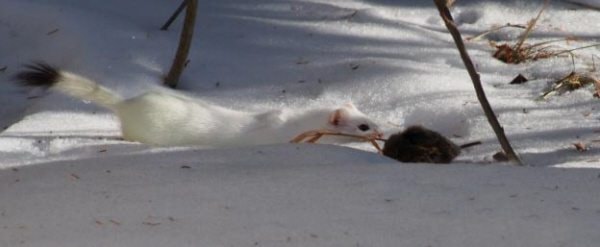By Myrna Pearman
Our wild neighbours have evolved remarkable ways to cope with snow. For the mammals that have to move through or atop the snowpack, two body attributes apply—size and foot loading. Larger mammals, such as moose and wolves, can obviously move easier through deeper snow than deer or coyotes. But as the snowpack continues to thicken, “foot loading” becomes a factor. Foot loading is the amount of pressure exerted (and therefore sink experienced) when an animal walks on the snow. Deer, with their stiletto-like legs, have extremely high foot-loading; their pointed hooves puncture even the hardest snowpack. By contrast, snowshoe hares and Canada lynx are at the opposite extreme: their wide fluffy feet exert such minimal pressure that they can quite literally “float” on the snow.
Snowshoe hares turn white in the winter and, with low foot load, can easily move atop the snow pack. When hares run, their large back feet land in front of their smaller front feet, so it is always easy to tell which direction they are travelling. Even with their ability to float, hares often follow well-trodden pathways through the forest.
Short-tailed weasels rely on their white pelage for camouflage during the winter, and their small tube-like bodies make it easy to dive down to the bottom of the snowpack to hunt for small rodents that remain active all winter under the snow.
Coyotes have little trouble moving through shallow snow but they must expend an increasing amount of energy as the snowpack thickens. They will often concentrate their activities during deep-snow winters to areas where they can move easier: e.g., dense tree cover, in urban neighbourhoods, along deer trails, snowmobile tracks, roads etc.
Red squirrels remain active all winter long but will retreat to their snug winter nests when the temperatures get extremely cold. For food, they rely on the large larder of spruce cones that they have cached away during the fall. They are able to move easily atop the snow pack, even with it is fresh and fluffy.
